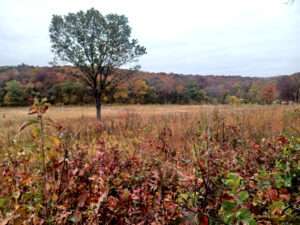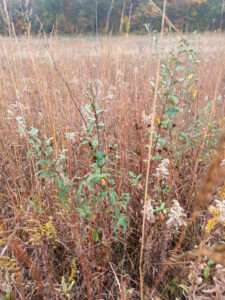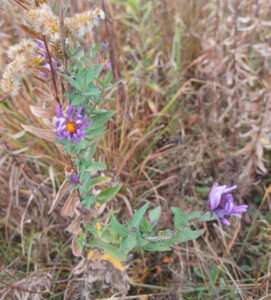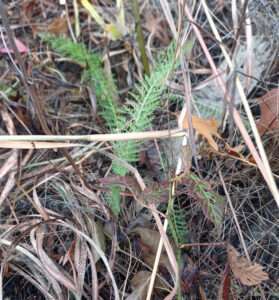 I’m in the middle of my fall peregrinations, currently staying with family in the Missouri Ozarks as my base of operations while I do some exploring of the area, and get up to my preferred flavor of trouble. Which, of course, includes volunteering.
I’m in the middle of my fall peregrinations, currently staying with family in the Missouri Ozarks as my base of operations while I do some exploring of the area, and get up to my preferred flavor of trouble. Which, of course, includes volunteering.
I actually got to do a little back home at Willapa National Wildlife Refuge right before I left town. They’re doing some coast meadow habitat restoration at the South Bay Unit, and so a whole pile of us showed up Wednesday before last to spend a few hours digging up invasive plants cropping up in some patches that had been intentionally planted with natives like early blue violet (Viola adunca), yarrow (Achillea millefolium), and pearly everlasting (Anaphalis margaritacea). I confess I didn’t get any pictures because I was A) pretty preoccupied with the upcoming trip, and B) nothing makes me zone out more than sitting with a trowel digging up weeds for hours at a time. By the time I get back the “nice” weather (aka warm and sunny) will likely be done for the year, but I’m hoping for more opportunities to get back out there.
But that certainly wasn’t the end of my habitat restoration efforts for the month. For the past couple of years, every time I come into Rolla, MO I stop at the Ozark Rivers Audubon Nature Center to see if they have any upcoming stewardship activities. They’ve done a beautiful job of restoring the remnant tallgrass prairie and oak savanna there and protecting the oak-hickory forest and that surrounds them, but invasive plants being what they are there are always more to be removed as the seed bank keeps new generations popping up.
This time around we were out in the prairie/savanna area with a bunch of folks from the officer training program down at Ft. Leonard Wood just down the highway. The objective was to remove as much of the autumn olive (Elaeagnus umbellata) as possible; this invasive shrub with a silvery underside to its green leaves can quickly shade out native prairie plants, and doesn’t offer local wildlife nearly as much food. Prescribed burns help knock it back, but some more resilient specimens manage to resprout, and of course there’s that pernicious seed bank in the soil.
 Most of these were much too large to simply pull up, so the most effective way to get rid of them was to go out in teams of two. One person uses loppers to cut the plant down as close to the ground as possible, and the other immediately dabs herbicide on the fresh stump, which then kills the roots and keeps the plant from regenerating. It’s a minimal use of the product when compared to spraying wide areas of foliage, and only treating the stump with a quick, targeted dab minimizes the chance of accidentally affecting surrounding native species. And since it doesn’t cause disturbance to the soil like digging would it’s less likely to stir up seeds that would then be even more likely to sprout.
Most of these were much too large to simply pull up, so the most effective way to get rid of them was to go out in teams of two. One person uses loppers to cut the plant down as close to the ground as possible, and the other immediately dabs herbicide on the fresh stump, which then kills the roots and keeps the plant from regenerating. It’s a minimal use of the product when compared to spraying wide areas of foliage, and only treating the stump with a quick, targeted dab minimizes the chance of accidentally affecting surrounding native species. And since it doesn’t cause disturbance to the soil like digging would it’s less likely to stir up seeds that would then be even more likely to sprout.
I know herbicides are super controversial–they’re not my favorite thing either. But as I wrote in my chapbook Habitat Restoration: What It Is, Why It’s Important, and How to Get Started, judicious and careful use in habitat restoration is one of the few times I’m okay with it, and it’s about the only way to reliably get rid of some invasive plants permanently. Given that invasive species removal is one of THE best ways to make an ecosystem more resilient in the face of climate change, habitat restoration has to be a big priority now and going forward. While I am not ignorant of the environmental impact of routine overuse of herbicides in agriculture and yards alike, the targeted use of them in habitat restoration is definitely a “lesser of two evils” situation that deserves more nuance.
While autumn olive was the main target, we also managed to remove a few other pernicious invasives. Callery pear (Pyrus calleryana) was easy to spot with its leaves still bright green amid the various browns, golds, and reds of native vegetation. We also got rid of some privet (Ligustrum spp.), and a little Japanese honeysuckle (Lonicera japonica) winding its way through the meadow. While there’s still plenty to go around for the next volunteer crew, we did make a big dent in that area.

It wasn’t just the invasive species in evidence, though; there were plenty of native plants to enjoy along the way. One of the most prominent was field goldenrod (Solidago nemoralis nemoralis), and while some had gone to seed others still had a touch of yellow. There was a splash of purple here and there from New England aster (Symphyotrichum novae-angliae), and delicate white snakeroot (Ageratina altissima) edged the treeline. Amid inland oats (Chasmanthium latifolium) and other native grasses, young northern red oaks (Quercus rubra) and white oak (Quercus alba) added splashes of scarlet. It was incredibly peaceful to be immersed in these beautiful species and more.
At a time when it’s all too easy to feel overwhelmed by the enormity of environmental devastation on multiple fronts, there is something empowering about getting my hands in the dirt, so to speak. No, removing some invasive shrubs from one remnant prairie won’t save the whole world. But it helps that ecosystem become more resilient, and gives the native species there a better chance. It also makes that place a better illustration of the grasslands that were much more common in this portion of the Midwest, and is an important reminder that it wasn’t always cornfields and cattle pastures.

On a microcosmic level, I just feel better after spending a few hours doing a little something good in the world. I felt better walking away knowing that native plants like this young yarrow I found beneath an autumn olive we removed will be more likely to thrive in the years ahead. I’ve absorbed some of the beneficial effects of being outside, too, and gotten a good bit of exercise at my own pace. And it’s good social time, too, in a setting that feels pretty darn comfortable, and we’re all united by a common interest in that moment. This is likely my last outdoor volunteer time of the year, but it was a great note to wrap things up on.
